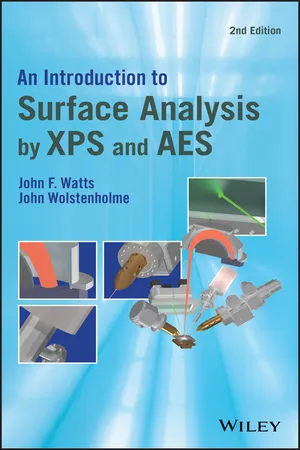
- English
- ePUB (mobile friendly)
- Available on iOS & Android
An Introduction to Surface Analysis by XPS and AES
About This Book
Provides a concise yet comprehensive introduction to XPS and AES techniques in surface analysis
This accessible second edition of the bestselling book, An Introduction to Surface Analysis by XPS and AES, 2nd Edition explores the basic principles and applications of X-ray Photoelectron Spectroscopy (XPS) and Auger Electron Spectroscopy (AES) techniques. It starts with an examination of the basic concepts of electron spectroscopy and electron spectrometer design, followed by a qualitative and quantitative interpretation of the electron spectrum.
Chapters examine recent innovations in instrument design and key applications in metallurgy, biomaterials, and electronics. Practical and concise, it includes compositional depth profiling; multi-technique analysis; and everything about samples—including their handling, preparation, stability, and more. Topics discussed in more depth include peak fitting, energy loss background analysis, multi-technique analysis, and multi-technique profiling. The book finishes with chapters on applications of electron spectroscopy in materials science and the comparison of XPS and AES with other analytical techniques.
- Extensively revised and updated with new material on NAPXPS, twin anode monochromators, gas cluster ion sources, valence band spectra, hydrogen detection, and quantification
- Explores key spectroscopic techniques in surface analysis
- Provides descriptions of latest instruments and techniques
- Includes a detailed glossary of key surface analysis terms
- Features an extensive bibliography of key references and additional reading
- Uses a non-theoretical style to appeal to industrial surface analysis sectors
An Introduction to Surface Analysis by XPS and AES, 2nd Edition is an excellent introductory text for undergraduates, first-year postgraduates, and industrial users of XPS and AES.
Frequently asked questions
Information
1
Electron Spectroscopy: Some Basic Concepts
1.1 Analysis of Surfaces
- It must be extremely sensitive.
- It must be efficient at filtering out signal from the vast majority of the atoms present in the sample.
- Which elements are present in the near‐surface region of a solid?
- Which chemical states of these elements are present?
- How much of each chemical state of each element is present?
- What is the spatial distribution of the materials in the near surface region in three‐dimensions and how does that vary with time?
- If material is present as a thin film at the surface:
- How thick is the film?
- How uniform is the thickness?
- How uniform is the chemical composition of the film?
Table of contents
- Cover
- Table of Contents
- Preface to First Edition
- Preface to Second Edition
- Acknowledgements
- 1 Electron Spectroscopy: Some Basic Concepts
- 2 Electron Spectrometer Design
- 3 The Electron Spectrum:
- 4 Compositional Depth Profiling
- 5 Multi‐technique Analysis
- 6 The Sample
- 7 Applications of Electron Spectroscopy in Materials Science
- 8 Comparison of XPS and AES with Other Analytical Techniques
- Glossary
- Bibliography
- Appendix 1: Auger Electron Energies
- Appendix 2: Table of Binding Energies Accessible with Al Kα Radiation
- Appendix 3: Documentary Standards in Surface Analysis
- Index
- End User License Agreement